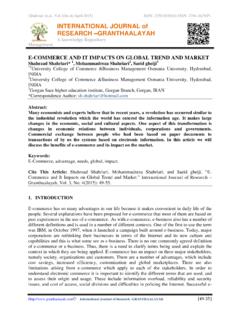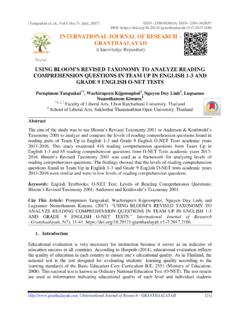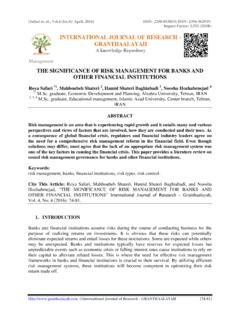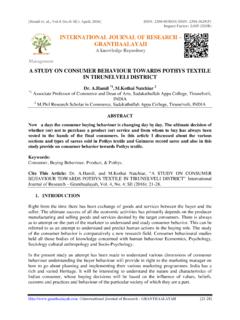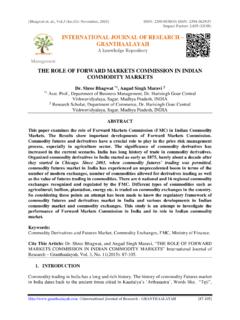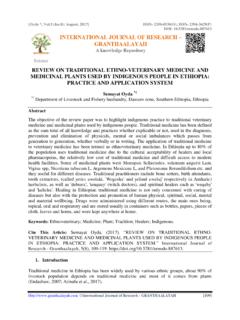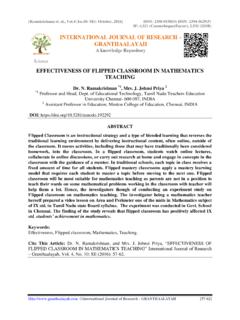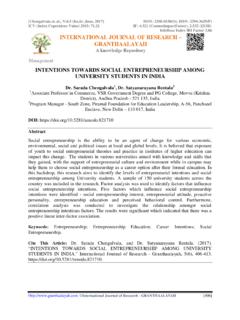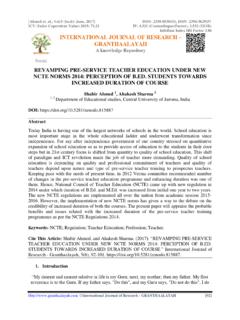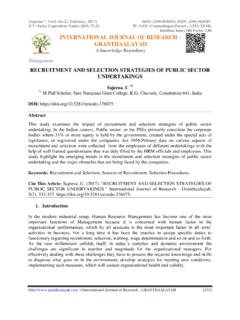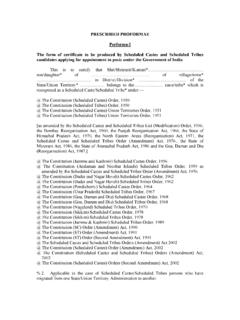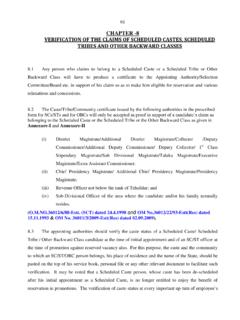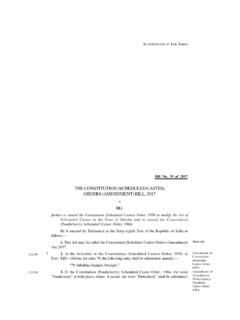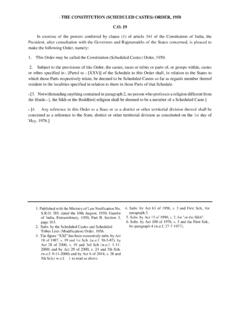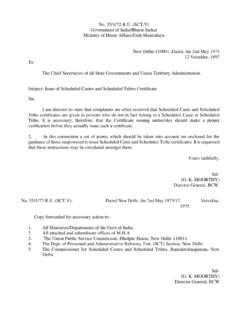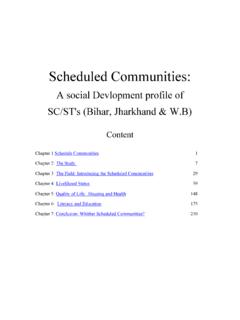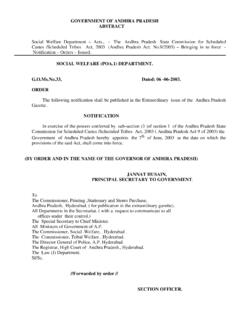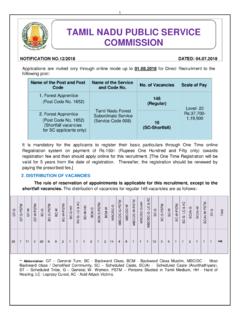Transcription of SOCIO-ECONOMIC STATUS OF SCHEDULED TRIBES IN …
1 [Jayakumar et. al., ( : SE): March, 2016] ISSN- 2350-0530(O) ISSN- 2394-3629(P) Impact Factor: (I2OR) International Journal of Research - GRANTHAALAYAH [22-30] Management SOCIO-ECONOMIC STATUS OF SCHEDULED TRIBES IN KALRAYAN HILLS Prof. A. Jayakumar *1, P. Palaniyammal 2 *1 Professor of Commerce & Former Controller of Examinations, Periyar University, Salem, INDIA 2 , Research Scholar, Department of Commerce, Periyar University Salem, INDIA ABSTRACT Social and economic justice, equality of STATUS and opportunities and cultural and educational STATUS are insured by the Constitution of India for all citizens and also provide enriched provisions for SCHEDULED caste and TRIBES . This paper addresses the socio economic STATUS of the SCHEDULED TRIBES in kalrayan hills Salem district Tamilnadu (India).
2 The majority of the household occupations are Agriculture. Cultivation is the primary occupation participated by the most heads of the sample households. Income from cultivation support majority of the sample population. More than 83 percent of the agriculture has from income around below Rs 5000-10000 level. Even daily wage labours are present in the sample population. There is a need to put more attention on educational aspects of SCHEDULED TRIBES , where this only can motivate them for future life. Keywords: Socio Economic STATUS , Tribal People, agriculture, Kalrayan Hills, Salem District, Tamilnadu. Cite This Article: Prof. A. Jayakumar, and P. Palaniyammal, SOCIO-ECONOMIC STATUS OF SCHEDULED TRIBES IN KALRAYAN HILLS International Journal of Research Granthaalayah, Vol. 4, No. 3: SE (2016): 22-30. 1. INTRODUCTION Development of the tribal s should be according to the lines of their own thinking -Jawaharlal Nehru The tribal population is identified as the aboriginal inhabitants of our country.
3 For centuries, they have been living a simple life based on the natural environment and have developed cultural patterns congenial to their physical and social environment. References of such tribal groups are found even in the literature on the ancient period, right from the Ramayana and the Mahabharata periods (Mehta, 2000). According to tribe is a social group with definite territory, common name, common descent, common culture, behavior of an endogamous group, common taboos, existence of distinctive social and political system, and full faith in leaders and self-[Jayakumar et. al., ( : SE): March, 2016] ISSN- 2350-0530(O) ISSN- 2394-3629(P) Impact Factor: (I2OR) International Journal of Research - GRANTHAALAYAH [22-30] sufficiency in their distinct economy (Vidyarthi, 1981).
4 There are approximately two hundred million tribal people in the entire globe, which means, about 4% of the global population. They are found in many regions of the world and majority of them are the poorest amongst poor. According to India s most recent census in 2011 Schedule TRIBES comprise of the population. 2. SCHEDULED TRIBES IN INDIA SCHEDULED TRIBES (STs) are indigenous, have their own distinctive culture, are geographically isolated and are low in SOCIO-ECONOMIC conditions. For centuries, the tribal groups have remained outside the realm of the general development process due to their habitation in forests and hilly tracts. After independence, Government of India has SCHEDULED the tribal groups in the Constitution and provided special provisions for their welfare and developments in the case of ST communities across the States in India and 75of the STs are most backward and are termed as Primitive Tribal Groups.
5 Most of the tribal areas are hilly, inaccessible undulating plateau lands in the forest areas of the country resulting in the bypassing of general developmental programmes. Due to this, infrastructure and development facilities in tribal areas for education, roads, healthcare, communication, drinking water, sanitation etc. Lagged behind compared to other area which has India being the second largest tribal dominated area after Africa is one of the most fascinating Nations of World from anthropological point of view. The total tribal populations of India, is per cent (census of India, 2011). As many as 550 tribal communities are residing in India, of whom 75 are declared as primitive tribal groups who are spread across the country. The tribal population is identified as the aboriginal inhabitants of our country. They are seen in almost every State of India. For centuries, they have been living a simple life based on the natural environment and have developed cultural patterns congenial to their physical and social environment.
6 References of such tribal groups are found even in the literature on the ancient period, right from the Ramayana and the Mahabharata period. Percentage of SCHEDULED TRIBES in State's total population, India (1981-2011) NORTH EASTERN REGION 1981 1991 2001 2011 Assam Manipur Mehalaya Nagaland Tripura Arunachal Pradesh Sikkim Mizoram NORTHERN Himachal pradesh 4 [Jayakumar et. al., ( : SE): March, 2016] ISSN- 2350-0530(O) ISSN- 2394-3629(P) Impact Factor: (I2OR) International Journal of Research - GRANTHAALAYAH [22-30] Sources: census report 2011 3. SCHEDULED TRIBES POSITION IN TAMILNADU The SCHEDULED TRIBES are constitutes ( million) in the total population of million of Tamil Nadu as per census 2011 which represents in the total population of India and it constitutes 36 castes.
7 Among the 36 STs, five STs are sharing majority of in the state ST population namely Malayali, Irular, Kattunayakan, Kurumans and Uraly. The human society plays a major role in the world we live in, even though the other parts and its nature are not understood. Come what may people think of them as spaced out from rest of the natural world. Human societies are unique in either way or other, still however they are found to share many vital characteristics. Hence at the onset it is necessary to establish the societies in order and to bring out the consequences of his relationship (Winfred Thames, 1985). Earlier ages before men lived in a society which survived on fierce hunting society and they purely depended on the existed natural sources within the survival limits. The incredibly increasing human and animal population, the pressured environment, the consumer markets and economics, the industrial development and other several related factors has resulted in the exploitation of natural resources.
8 This has resulted to the degradation of forests, several Uttar pradesh CENTRAL Madhya pradesh WESTERN Gujarat Maharashtra Rajasthan Dadra and Nagar Haveli 52 Goa 0 Daman and Diu SOUTHERN Andra pradesh Kerala Karnataka 7 Tamil Nadu 1 ISLAND Andaman and Nicobar Lakshadweep [Jayakumar et. al., ( : SE): March, 2016] ISSN- 2350-0530(O) ISSN- 2394-3629(P) Impact Factor: (I2OR) International Journal of Research - GRANTHAALAYAH [22-30] environmental problems and has consequently led to the fall off of homeland of native tribal. The primitive methods of farming, agriculture, shifting cultivation and exploitation of the forest produces by the millions of people living within and out of the forest has lead to major forest loss.
9 Though India has bequethed unique flora and fauna by the nature, the Indian tradition and its heritage seems to be an amalgamation of a wide variety of colorful cultures. Urban, rural, folk, archaic and modern cultures are devised into the aboriginal civilization of India. Similarly the varied ethinicities, multi linguistics and diferent religion have been synchronized in Indian traditions. The Indian civilization is hence a plural society with a potpourri of traditions. 4. IMPORTANCE OF THE STUDY The main problem in the society is that there is no proper awareness and understanding the tribal people. In government point of view, even the government has taken lot of schemes benefiting to them; the whole benefits not reached them properly. Most bankers hesitate to give loans to them, because they don t have proper income and STATUS in the society the aims of the study are to identify to what extent the concept of tribal people in Kalrayan Hills.
10 In addition the study focuses on the need and importance of financial and non-financial support to overall well-being and empowerment of the tribal people in Kalrayan Hills. 5. STATEMENT OF THE PROBLEM The economic problems need special attention in the context of tribal communities of India. Available research studies point out that the tribal population has distinctive health. Insanitary conditions, ignorance, ST population continue to carry burdens of diseases of the poor , namely under nutrition and infection diseases. They are dominated, exploited and controlled by the mainstream. The TRIBES in Kalrayan Hills have poor infrastructure facilities, the problems related to various aspects of tribal people in kalrayan hills viz. social, economical, educational, health, religion, an, law and order situation, self-centered tendency and so on, and they got meager facilities from the Government as the government schemes normally designed for the average district or village, which is not a reality where TRIBES are concerned.
